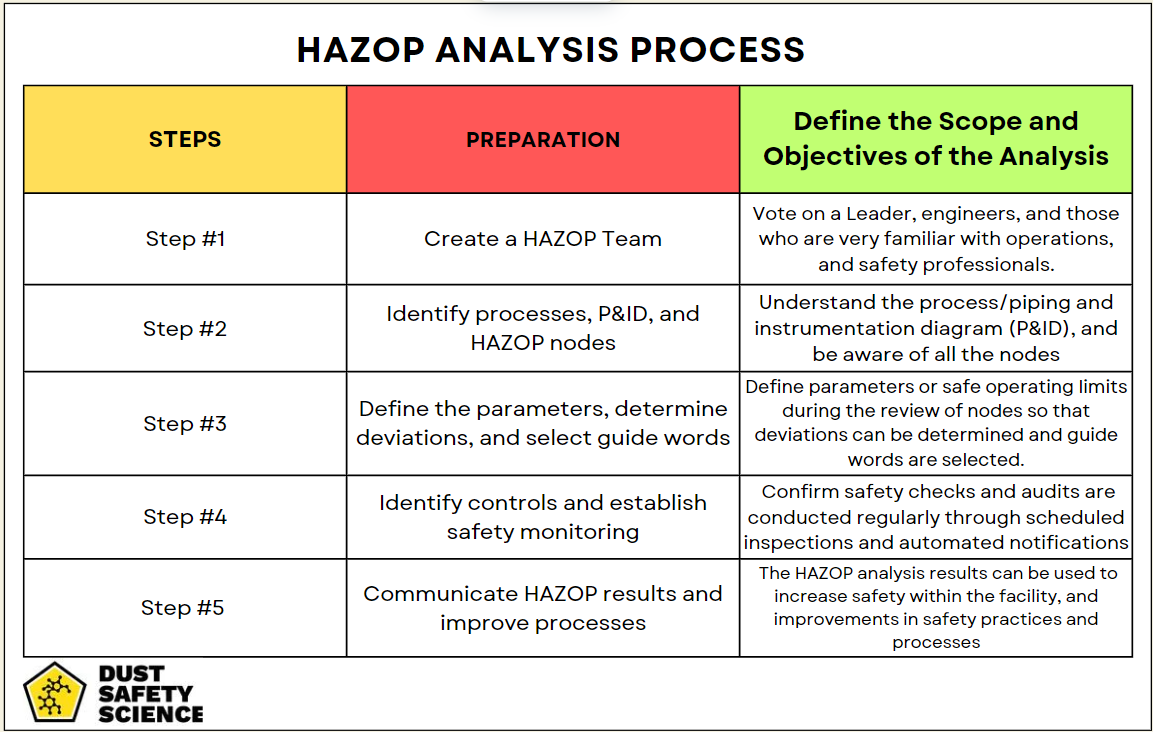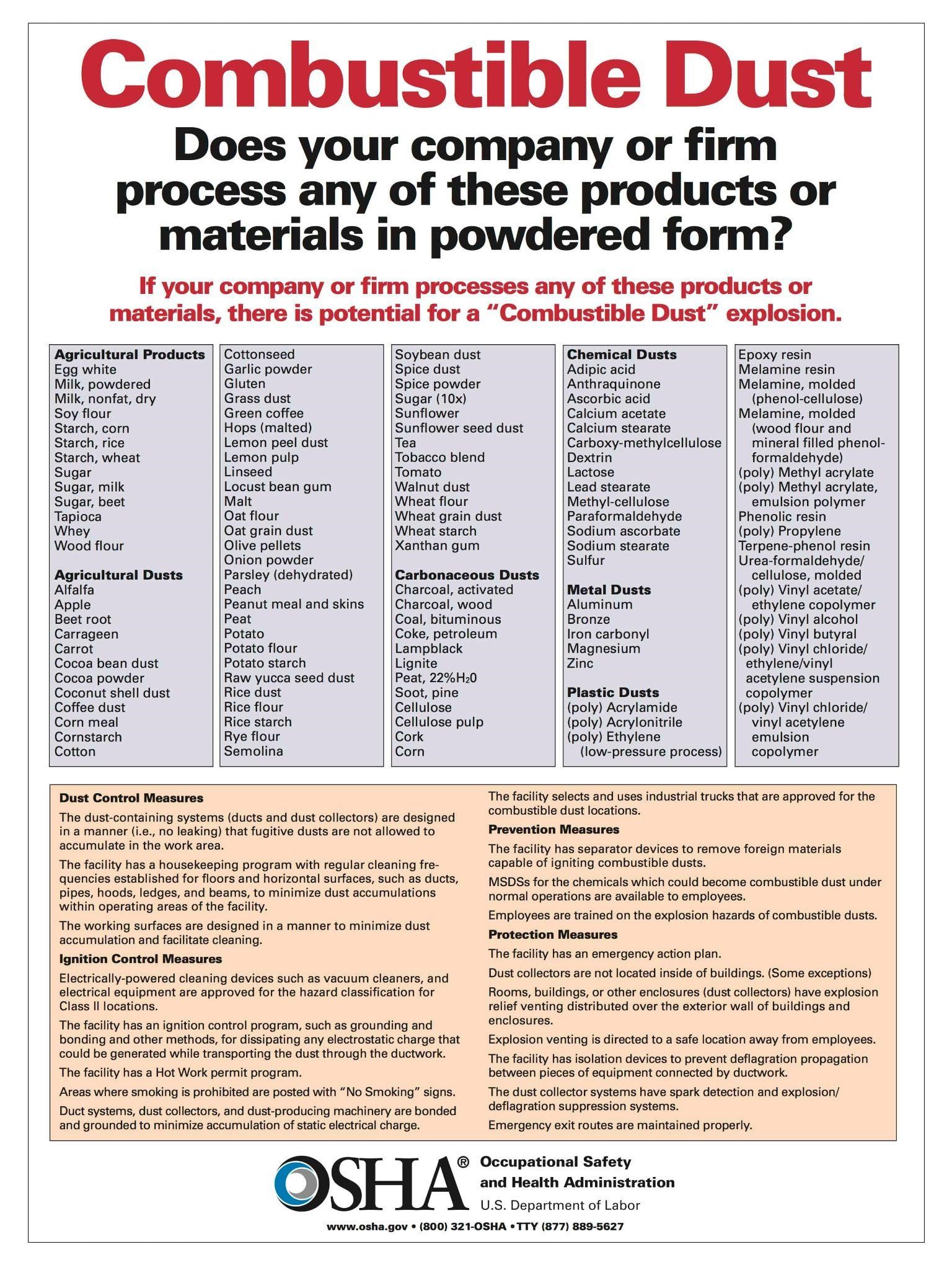Published August 8, 2024 Authored by Dr. Chris Cloney and Jon Barrett of Dust Safety Science

What is HAZOP?
HAZOP, or Hazard and Operability Study, is a structured and systematic examination of a planned or existing process or operation. The primary goal is to identify and evaluate the process’s risks and recommend measures to enhance safety and operability. According to Wikipedia, a HAZOP is a critical tool for safety analysis, helping organizations prevent accidents and improve overall process efficiency. HAZOP is a systematic technique used to identify and evaluate potential hazards and operational issues within a process or system. This systematic approach is crucial in preempting safety concerns, ensuring smooth operations, and mitigating risks, especially in industries dealing with combustible materials.
Historically, HAZOP was developed by Imperial Chemical Industries, (ICI), in the 1960s. Its evolution over the decades has seen it become a standard practice in various industries worldwide. Initially applied in the chemical industry, its success has led to its adoption in numerous other fields where safety and operability are paramount concerns.
Key Principles of HAZOP
The methodology of HAZOP is grounded in a few key principles designed to uncover potential hazards systematically. These principles include:
- Guide Words: Standardized terms used to prompt thought about how process parameters might deviate from the intended design.
- Deviations: Variations from the expected performance or process conditions that could lead to hazardous situations.
- Nodes: Specific sections of the process under review, typically identified by equipment or operational steps.
- Team Approach: Collaboration among a multidisciplinary team to ensure comprehensive analysis.

Steps Involved in Conducting a HAZOP Analysis
There are 4 main processes when ideating and conducting a HAZOP Analysis:
- Preparation: Define the scope and objectives, of the HAZOP Analysis
- Team Creation: Create the team, gather relevant documents, and schedule meetings.
- Execution: Conduct the study by systematically examining each node, identifying deviations using guide words, and analyzing potential risks.
- Follow-up: Document findings, develop recommendations, and track the implementation of corrective actions.
There are several steps involved when creating and executing a HAZOP Analysis:
Step #1: Create a HAZOP team
Create a multidisciplinary HAZOP team composed of a team leader and members who can collaborate and provide different perspectives based on their fields of expertise to realize sources of risks and possible deviations from design. An example of HAZOP team members would be design engineers, those who are very familiar with operations, and safety professionals. A successful HAZOP study relies on the expertise and collaboration of a diverse team. The typical composition includes:
- Team Leader: Facilitates the study, ensures methodology adherence, and maintains focus.
- Recorder or Scribe: Records all discussions, findings, and recommendations in detail.
- Subject Matter Experts (SMEs): Provide in-depth knowledge of the process, equipment, and potential hazards.
- Operators: Offer practical insights into the operational aspects and potential issues.
- Engineers: Contribute technical expertise and solutions for identified risks.
Step #2: Identify Processes, P&ID, and HAZOP nodes
When beginning a HAZOP study, it is important to identify the processes in operations, be familiar with the process/piping and instrumentation diagram (P&ID), and be aware of all the nodes. P&IDs are drawings or diagrams that provide a visual representation of interconnected processes, equipment, and controls in the physical plant.
HAZOP nodes are sections in the entire process where changes happen and they need to be reviewed along with Material Safety Data Sheets (MSDS) so that parameters can be defined and deviations are identified. Identify the nodes or specific sections of the process to be analyzed. Nodes are typically defined by equipment, functional units, or control systems.
Step #3: Define the Parameters, Determine Deviations, and Select Guide Words
Define parameters or safe operating limits during the review of nodes so that deviations can be determined and guide words are selected. Analyze the potential causes, risks, and consequences of each identified deviation.
Examples of common HAZOP guidewords and parameters include:
|
Guideword |
Meaning |
|
No (not, none) |
None of the design intent is achieved |
|
More (more of, higher) |
Quantitative increase in a parameter |
|
Less (less of, lower) |
Quantitative decrease in a parameter |
|
As well as (more than) |
An additional activity occurs |
|
Part of |
Only some of the design intention is achieved |
|
Reverse |
The logical opposite of the design intent occurs |
|
Other than (other) |
Complete substitution (another activity takes place, or an unusual activity occurs or an uncommon condition exists) |
With the use of guide words, workplace hazards can be identified as they are deviations that go beyond acceptable parameters or safe operating limits.
Step #4: Identify controls and establish safety monitoring
With hazards identified, hazard mitigation or elimination strategies should be applied to maintain the safety of the workplace. With continuous processes and production, monitoring should also be established to ensure that safeguards are still effective and safety procedures are being followed. Monitoring is only effective when it is conducted regularly. Confirm safety checks and audits are conducted regularly through scheduled inspections and automated notifications.
Step #5: Communicate HAZOP results and improve processes
The result of the HAZOP analysis can be used to help elevate safety within the plant and improvements in safety practices and processes should be communicated as appropriate to employees and safety personnel. Develop recommendations to mitigate identified risks. Document all findings and recommendations in a detailed report, which will serve as a benchmark for implementing safety measures. As a result, safety training or programs will implement the changes and reinforce safety in the entire facility.

HAZOP in the Context of Dust and Dust Explosions
Industries handling combustible dust, such as mining, agriculture, and food processing, face unique challenges. HAZOP studies can be instrumental in identifying and mitigating risks associated with combustible dust accumulation and dust explosions. Combustible dust refers to finely divided solid particles that are prone to ignition when suspended in the air. These particles can originate from various materials and industries, including agriculture, manufacturing, and chemical processing.
The Occupational Safety and Health Administration (OSHA) in the United States defines combustible dust as “a solid material composed of distinct particles or pieces, regardless of size, shape, or chemical composition, which presents a fire or deflagration hazard when suspended in air or some other oxidizing medium over a range of concentrations.” Dust qualifies as combustible when it possesses specific characteristics that make it prone to ignition and combustion when suspended in the air, as a dust cloud, and as a result, creates a combustible dust explosion.
Special Considerations for Dust Control and Explosion Prevention
- Dust Accumulation: Identifying areas where dust can accumulate and become a hazard.
- Ignition Sources: Evaluating potential sources of ignition and implementing controls to minimize these risks.
- Ventilation Systems: Ensuring adequate ventilation to prevent dust buildup.
- Maintenance Practices: Developing protocols for regular cleaning and maintenance to reduce dust accumulation.
By addressing these specific concerns, HAZOP helps in preventing catastrophic dust explosions.
Case Studies Involving Dust Explosions and HAZOP
Case Study 1: Grain Elevator Explosion
In a grain elevator facility, a HAZOP study identified the potential for dust accumulation in confined spaces. By implementing improved ventilation and regular cleaning protocols, the facility significantly reduced the risk of a dust explosion.
Case Study 2: Chemical Manufacturing Plant
A chemical plant dealing with fine powders conducted a HAZOP study that highlighted the need for better control of static electricity, a known ignition source for dust explosions. By grounding equipment and using antistatic materials, the plant mitigated this risk effectively.
Lessons Learned
These case studies underscore the importance of HAZOP in proactively identifying and addressing potential hazards. The outcomes not only enhanced safety but also led to the development of more robust safety protocols, benefiting the entire industry.
Advantages and Limitations of HAZOP
Advantages
- Comprehensive Risk Identification: HAZOP’s systematic approach ensures thorough identification of potential hazards.
- Collaborative Process: The multidisciplinary team approach fosters a holistic understanding of the process and its risks.
- Improved Safety: Implementation of HAZOP recommendations leads to enhanced safety and operational efficiency.
Limitations
- Resource Intensive: HAZOP studies can be time-consuming and require significant resources, including personnel and documentation.
- Complexity: The process can be complex and may require specialized training and expertise.
- Subjectivity: The quality of the analysis can be influenced by the experience and knowledge of the team members.
Despite these limitations, the benefits of HAZOP in enhancing industrial safety far outweigh the challenges.
Complementary Safety Practices
HAZOP is most effective when integrated with other safety management systems. For instance:
- ISO 45001: HAZOP can complement ISO 45001 by providing detailed hazard analysis that feeds into the broader occupational health and safety management system.
- Safety Integrity Level (SIL) Assessments: HAZOP findings can inform SIL assessments, ensuring that safety instrumented systems are appropriately designed and maintained.
Role of Continuous Improvement and Safety
A strong safety culture and a commitment to continuous improvement are crucial for maximizing the benefits of HAZOP. Regular reviews, training, and updates to safety protocols ensure that risks are continually managed and mitigated.
AI and Automation Technologies
Integrating AI and automation technologies into HAZOP studies and analysis represents a significant advancement in enhancing safety and efficiency. These technologies can streamline the HAZOP process by automating routine tasks, such as data collection and deviation analysis, allowing teams to focus on more complex decision-making.
AI algorithms can analyze large volumes of operational data to identify patterns and predict potential hazards that might be overlooked in traditional studies. Furthermore, automation can facilitate real-time monitoring of processes, enabling the early detection of deviations and swift implementation of corrective measures. By incorporating AI and automation into HAZOP, industries can achieve a more dynamic and responsive approach to risk management, ultimately leading to safer and more reliable operations.
Conclusion
In conclusion, HAZOP is a vital tool for maintaining industrial safety. Its systematic approach to identifying and mitigating hazards helps prevent accidents, protect lives, and ensure operational efficiency. By adopting HAZOP studies as a standard practice, industries can continuously assess and manage risks, fostering a safer and more reliable operational environment. Embracing HAZOP not only enhances safety but also contributes to the sustainable growth and success of industrial operations.
About Dust Safety Science
Dr. Chris Cloney, of Dust Safety Science, provides additional information on a Dust Hazard Analysis, with a Podcast. Click on the latest Podcast Link: What Details Should Be Included in a DHA

Resources:
Visit Dust Safety Science (Global Incident Tracking)
Visit Dust Safety Academy (Resources, Training, and Events)
Visit Dust Safety Professionals (Need Help? Get Support Today!)
Visit Dust Safety Journal for the Complimentary, Dust Safety Science Monthly Journal
Subscribe to our Complimentary, Dust Safety Science Newsletter at Dust Safety Science Newsletter
Visit the Dust Safety Science blog for written articles on combustible dust safety including the latest research, expert opinions, and state-of-the-art fire and explosion protection.
